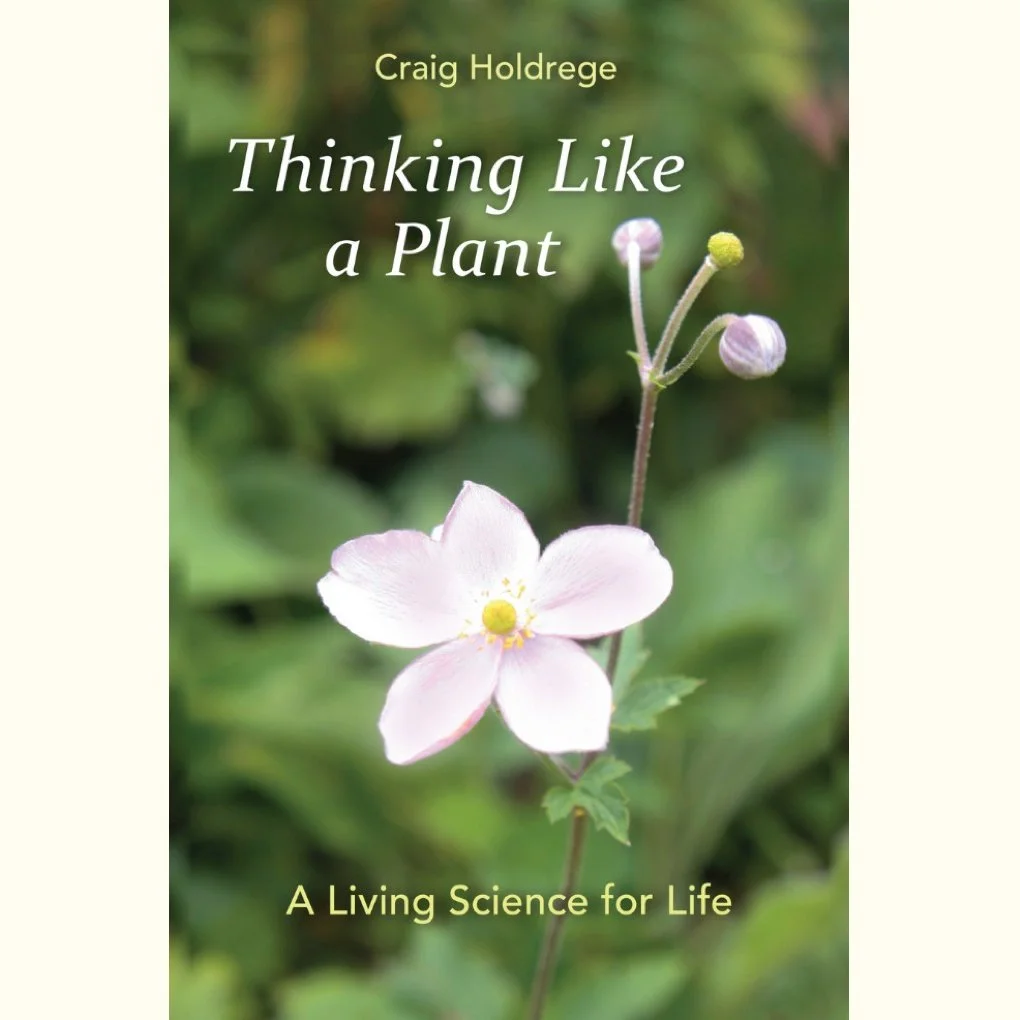Thinking Like a Plant — A Living Science for Life
Thinking Like a Plant — A Living Science for Life
Craig Holdrege
Great Barrington, MA: Lindisfarne, 2013
(softcover, 217 pages)
Who would imagine that plants can become master teachers of a radical new way of seeing and interacting with the world? Plants are dynamic and resilient, living in intimate connection with their environment. This book presents an organic way of knowing modeled after the way plants live.
When we slow down, turn our attention to plants, study them carefully, and consciously internalize the way they live, a transformation begins. Our thinking becomes more fluid and dynamic; we realize how we are embedded in the world; we become sensitive and responsive to the contexts we meet; and we learn to thrive within a changing world. These are the qualities our culture needs in order to develop a more sustainable, life-supporting relation to our environment.
While it is easy to talk about new paradigms and to critique our current state of affairs, it is not so easy to move beyond the status quo. That’s why this book is crafted as a practical guide to developing a life-infused way of interacting with the world.
Listen to a conversation about Thinking Like a Plant.
TABLE OF CONTENTS
Introduction
Chapter 1. From Object thinking to Living Thinking
The Objective Attitude
Object thinking
The Logic of Solids
Object thinking Applied
Educating to Disconnect
Losing the Experienced World
Beyond Object thinking?
From Object thinking to Living Thinking
Chapter 2. Rooted in the world
Becoming Rooted—Perception
Into the Phenomena
Nature Drawing
Sauntering of the Senses
Exact Sensorial Imagination
Openness and Preconceptions
Becoming Aware of Thinking
Chapter 3. The Plant as Teacher of Transformation
Plant Development—The Field Poppy
Leaves: Transformation, Expansion, and Contraction.
Process Thinking
Bringing Forth and Letting Go
Expansion and Contraction in Learning
Flowering Thought—Insight
Leaf Metamorphosis
Metamorphosis in the Flower
A Shape-Shifting Proteus
Unity in Diversity—Living Ideas and Wholeness
Some Implications
Chapter 4. The Plant as a Teacher of Context
A Plant in its Context
Light and Plant Form
Tree Forms
Plant-Environment: A Dynamic Unity
Plasticity
The Reciprocal Relation between Plant and Environment
Context Sensitivity
Relational Reality
Participation
Dialogic Inquiry
Delicate Empiricism
Darwin: Exploration and Theory
Evolving Knowledge
Chapter 5. The Story of an Organism
The Importance of Story
The Story of Common Milkweed
Vegetative Development
From Flower to Fruit
Flower Morphology and Pollination
Abundant Animal Life
The Extended Organism
Summarizing Picture
Leopold’s “Thinking Like a Mountain”
Chapter 6. Conclusion: A Quiet Revolution
The Plant’s Teachings--A Summary
Education and the “Treacherous Idea” of Preparation
Learning From Genuine Presences
The Developing Human Being
Adult Education at The Nature Institute
Who Are You?
Sustainability and Education
Where Do All These Plants Come From?
REVIEWS
“Thinking Like a Plant is an exciting practical guide as well as a compendium of descriptions and ideas of his findings as a researcher and an educator. In Craig Holdrege’s words, ‘by engaging in the concrete we can escape the grasp of the abstract.’ His book, which is nicely produced and very approachable in its size, mines several rich seams of biological, ecological, and psychological reality and I definitely recommend it.”
— Jackie Bortoft in Holistic Science Journal.
“Over the years I have read many books on ecology and sustainability, and I can say without hesitation that this is one of the very best, destined to become a classic. Read it, connect with plants, and feel yourself expand tenderly and powerfully into our marvelous world.”
— Stephan Harding in Resurgence and Ecologist
“I strongly recommend Thinking Like a Plant to scholars and students of environmental philosophy and the ecological humanities. It compellingly argues that in order to address the environmental crisis, we not only need to change what we think but how we think, and that plants can guide us in this transformation. Thinking Like a Plant offers a rich account of how plants can serve as a model for an ecological attunement to the world.”
— Luke Fischer in Environmental Philosophy
“This is much more than a book about plants, although it has much to say about how we can develop the faculties for a much deeper appreciation of the living beings we call plants. If we are receptive and awake to what a plant is, how it lives and grows, there are profound implications for the environmental movement, the philosophy of science, and for education at all levels.”
— Richard Katz in Flower Essence Society
“Thinking Like a Plant refuses to fall into a category — philosophy? nature study? ecology? education? botany? how-to? By turns it is each of these, but it aims at an interdisciplinary wholeness that transcends these.... It aims at a genuine wholeness, what Henri Bortoft calls ‘upstream thinking,’ the reunification of disciplines and subjects that have become separated and fragmented over the past centuries.”
— Stephen Sagarin in Research Bulletin for Waldorf Education

